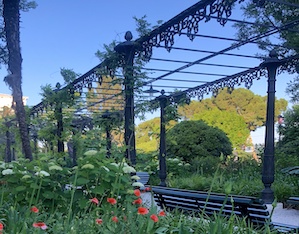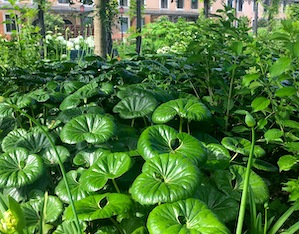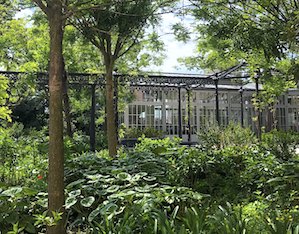A veritable oasis a stone’s throw from Piazza San Marco, these gardens were conceived in Venice when it was under Napoleonic government, and were much loved by Empress Sissi. The gardens have recently been restored to their former glory: a wondrous combination of leafy plants growing in the gentle shade of a sophora wood.
When the Marciana district was under renovation by Napoleon and his viceroy Eugenio di Beauharnais, the Procuratie Nuove was converted into a royal residence. Although it was partially modified in later years, the design, by Royal architect Giovanni Antonio Antolini (1753-1841), featured a garden overlooking the San Marco Basin. Over a drawbridge crossing the Procuratie Nuove canal, the gardens were added on to the property, featuring a series of elements inspired by traditional Italian-style gardens. After the Austrians retook Venice, architect Lorenzo Santi (1783-1839) completed the gardens by adding a tree-lined avenue overlooking the Basin, geometric Italian-style parterres, and two English-style groves. Between 1815 and 1817, he added a greenhouse on Zecca bridge and, to lend perspective to this new thoroughfare, crowned the view with an elegant neoclassical pavilion, the Cafehaus. In 1857, when Emperor Franz Joseph opened the avenue facing the Basin for public use, a long iron and cast iron pergola was added to provide a shady walk. After years of neglect, the “Venice Gardens Foundation” chaired by Adele Re Rebaudengo commissioned architect Paolo Pejrone to restore the Royal Gardens and oversee its botanical management. Its formal value and botanical complexity revived, the gardens reopened in December 2019. Exotic plants now grow alongside long-established evergreen shrubs, paying homage to the Serenissima’s heritage and taking into account its unique brackish environment. Groves of sophora shade hydrangeas and ligularia; more than five thousand agapanthus (and, in spring, daffodils and tulips) bloom in the parterres. Large terracotta pots house pomegranates, figs, medlars, bitter oranges and glossy viburnums; clerodendrons and osmanthus provide their scent in the garden’s borders, while various species of bamboo surround the large greenhouse. Birds have returned to nest in the gardens’ renewed harmony.




